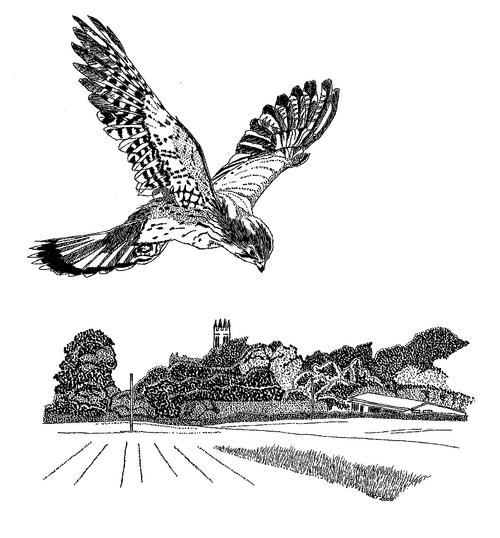Unrest in the ranks between Kestrel and Sparrowhawk
Mark E Turner
Since I started to pay serious attention to the burgeoning numbers of birds of prey some twenty years ago, I have been under the impression that the unpretentious demeanour of the Kestrel placed it somewhere near the bottom of raptorial hierarchy. On many occasion I have seen these delightful birds on the wrong end of a hook-billed aggressor, usually victims of piracy. However, birds have a knack of proving even the most seasoned observers among us wrong.
Kestrels are rarely encountered in the garden predating your favourite Blue Tits and are generally seen hovering angelically beside the road: they are not tarred with the same brush as, say, Sparrowhawks. Which leads me to an extraordinary event on 17th January 2007 that took me by surprise in more ways than one. We were living in Kemerton at the time; it was around 13.30 hrs and following a brief storm front passing through from the west, the sky cleared and it became brighter. As I stepped out onto the back patio to throw out a few crumbs from lunch for the birds, a juvenile female Sparrowhawk flew into our small enclosed garden carrying an item of prey. Hot on its tail was a juvenile male Kestrel which I believe was attempting to rob the hawk of its lunch. The two raptors did several circuits round the garden as I froze to the spot completely in the open. I could hear their claws grappling and clattering the fence panels as the Sparrowhawk scrambled for cover in the Leylandii hedge.
The hawk escaped with its meal by going to ground in our neighbour’s plot. The gardens back onto farmland fields, hunting territory for both these birds, the young Kestrel I certainly recognised and hawks regularly took small birds from garden feeding stations.
I would not normally have thought competition between local raptors for a meal was an issue, particularly during recent mild weather with an abundance of prey on offer. However, it appears Kestrels have aggressive piratical tendencies just as many other raptors do and I now see them in a different light.
So it seems our Sparrowhawks with their bad-boy image definitely do not have it their way as often as we make out and with a larger cousin making a healthy return to our forests, the poor Sparrowhawk has another reason to be fearful. An example of this occurred whilst I conducted my occasional raptor survey at a certain site in the North Cotswolds (southeast Worcestershire/Gloucestershire border) on 16th February 2009. The area comprising hillside farmland, conifer forest and mixed woodland, has hosted nine species of raptor, four of which are year-round residents, so there’s bound to be conflicts. On the day in question two Accipiters emerged from the large conifer wood on which I was focussing my attention: they were apparently engaged in a high speed chase. I believe both birds to have been males not dissimilar in their dark blue-grey upperparts, but quite different in size and shape. The pursuer having a greater head-profile and deeper chest pumped its wings hard to keep up with its slighter built quarry: Goshawk versus Sparrowhawk! I am not inclined to divulge site details to one and all, but it does lie within the county of Worcestershire where I have on several occasions enjoyed territorial displays of all the resident birds of prey including Goshawk.
Image
Fig. 1. Kestrel. Drawing ©Mark Turner.
